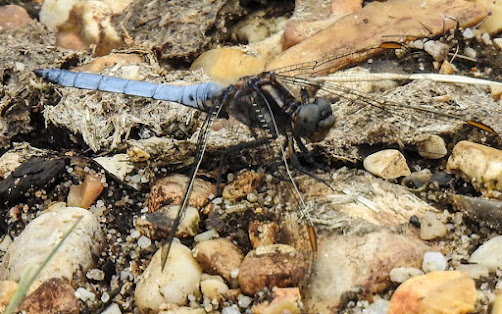The walk started
along the cliff on an overcast but warm dry morning. A House Martin was spotted
diving over the edge as we walked through the Thrift and Common Ragwort
growing amongst Bramble and Bracken. There was the first of many Meadow Brown
butterflies.
We crossed the
road and walked down Westminster Road to gate 12, where we entered the meadow.
Brian explained the work that is done by Milford Conservation Volunteers to
keep the area well maintained but natural.
.JPG) |
| Black & Yellow Longhorn Beetle © Tina Vaughan |
We went into the
Tony Locke Orchard, re-named after the ex-chairman of MCV (and also Lym Nats chairman a while back)
died last year. Since 2016 surveys have recorded 27 different species of
butterfly in the orchard and neighbouring common. A 7-spot Ladybird was resting
on an apple, and our first Marbled White butterfly was seen.
 |
| Marbled White © Tina Vaughan |
As we walked
along and read the sign warning us of Adders, a Kestrel swooped down and took a
small mammal from the long grass behind us. A bird feeder in a nearby garden
gave us the opportunity to watch a Great Spotted Woodpecker, Carrion Crow,
Greenfinch, Chaffinch and House sparrow. A Woodpigeon and Herring Gull flew
over and we heard a Pheasant calling.
The plants and
insects were plentiful, as like children, we walked through the purple flowered
Knapweed trying to capture pictures of fast moving Marbled White (dozens of
them), Meadow Brown, Small Skipper, and Small Copper butterfly. There was also
Common Red Soldier Beetle, Swollen-thighed (aka Thick-legged Flower-) Beetle and
a Golden-ringed Dragonfly circling over the poisonous Corky-Fruited
Water-Dropwort only found in a few counties of the UK, and the many species of
grasses, and more Ragwort. The meadow attracts both damp and dry loving plants
such as Meadow Buttercup, Marsh Thistle, Wild Thyme, Wood Sage, Eyebright,
Lesser stitchwort, and Meadow Vetchling and plenty of Bramble.
 |
| Swollen-thighed Beetle © Richard Coomber |
We entered the
Common, an area of scrub, trees and grassland. Gorse, Bramble, Honeysuckle and
a variety of small trees encouraged more butterflies – Common Blue, Large and
Small Whites, Small Copper, Large and Essex Skippers, Comma, an early Ringlet,
Gatekeeper and Red Admiral. Other insects included a Hornet Mimic Hoverfly (the
largest of the hoverflies), Meadow Grasshopper (female as it was pink), and
female Common Blue Damselfly. Not many birds as we drank our coffee, but a
Nuthatch was observed. Most of the trees were Oak and Sycamore, but new ones
such as Field Maple and Rowan have been planted.
Plants were
plentiful – Common Centaury, Hart’s-tongue fern, Agrimony, Perforate St
John’s-wort, Hedge Bedstraw, Rosebay Willowherb, Cleavers (aka as Sticky Willy,
Goosegrass), Germander Speedwell, Herb Bennet, Dog Rose (with Robin’s Pin
Cushion Gall), Dyer’s Greenweed (used to dye things lemon yellow since the
Vikings), Common Restharrow, Woody Nightshade (aka Bittersweet), Red Campion and
Spear Thistle.
 |
| Robin's Pin-cushion Gall © Tina Vaughan |
 |
| Dyer's Greenweed © Tina Vaughan |
A quick wander
down to the Danestream which feeds Sturt Pond, and we heard Blackcap,
Chiffchaff, and a Wren singing in the woods. A Broad leafed Helleborine (a tall
dark orchid) was noticed still in bud. A squirrel ran up a tree, as they do.
 |
| Wren © Richard Coomber |
We came back
through a Blackthorn hedge full of sloes, and Gorse . On entering the far side
of the meadow and heading back to gate 12, there were Scarlet Pimpernel, clovers,
Ribwort Plantain, docks, Field Bindweed and Selfheal. A commonly sighted
Buzzard flew over, and other birds seen were Goldfinches, Swallow, Blackbird, Magpie.
Due to the
excellent work by MCV, my species list has been long. There are so many in this
incredibly diverse habitat. Thank you to
everyone for their observations and shouts of “Tina” to ensure I
captured a record of everything. It was definitely a team effort. T&BV

























.JPG)




